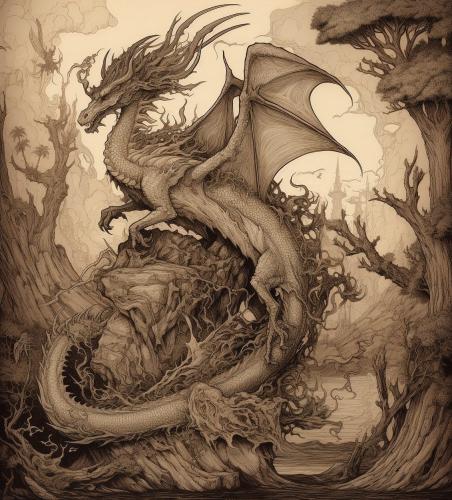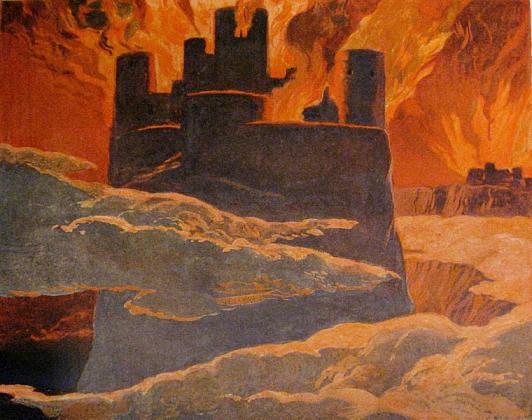Old Norse mythology has a number of fantastical creatures that captivate the imagination. In this world, one of the most enigmatic beings is Nidhogg, the fearsome serpent that dwells in the depths of the underworld. Join me as I uncover the vital role Nidhogg plays in Norse cosmology as tormentor of the doomed.
The impact of this terrifying creature stretches far beyond its immediate surroundings. Its actions have consequences for the entire universe, making it an essential figure in the Norse pantheon. He doesn’t only pass time gossipping with Ratatoskr, he is also always gnawing at the roots of Yggdrasil with his offspring. Moreover, he torments the souls of those dead banished to Náströnd, an especially gruesome part of Hel, waiting for Ragnarök.
Nidhogg Etymology and Conceptual Origins
The name “Nidhogg” in Old Norse is “Níðhöggr,” a compound of two words: “níð,” which translates to “malice” or “hatred,” and “högg,” meaning “to strike” or “to bite.” This sinister combination speaks volumes about the serpent’s destructive nature and its role in mythology.
Norse mythology is not without other serpents and dragons, such as the dragon Fafnir or famed Jörmungandr, the Midgard Serpent. However, Nidhogg’s domain is the underworld, making it unique among these creatures. Furthermore, its origin can be linked to broader Indo-European traditions, where serpent or dragon-like beings often appear as adversaries, embodying chaos or destruction.
Description and Physical Features

In Old Norse literature, Nidhogg’s appearance is not described in great detail. However, it is generally portrayed as a colossal serpent or dragon with razor-sharp fangs, fearsome scales, and a malevolent gaze. The very essence of Nidhogg symbolizes decay and corruption, constantly undermining the stability of the cosmos. The art of both ancient and modern times reflects this image.
The World Tree Yggdrasil and Nidhogg’s Role
Yggdrasil, the World Tree, serves as a cosmic pillar, uniting the Nine Realms of Norse mythology. Within this intricate web of interconnected worlds, Nidhogg finds its home in Náströnd, a part of the underworld reserved for the most wicked of souls. Here, the serpent eternally gnaws at Yggdrasil’s roots, contributing to the tree’s ceaseless cycle of decay and regeneration.
Nidhogg’s role is not solely one of destruction, though. As it chews at the roots, the serpent also interacts with other creatures in the mythos, such as Ratatoskr. This mischievous squirrel scurries up and down Yggdrasil, carrying messages and taunts between Nidhogg and the eagle perched high atop the tree. In this way, Nidhogg’s actions reverberate throughout the cosmos, influencing the lives of gods and mortals alike.
Nidhogg’s Connection to the Dead and the Afterlife
Nidhogg’s sinister dwelling in Náströnd, a part of the Norse underworld known as Helheim, is crucial to understanding its association with the dead and the afterlife. Náströnd, which translates to “Corpse Shore,” is a desolate and horrifying place reserved for those who have committed the most dishonorable acts in their lives. Here, murderers, oath-breakers, and other wrongdoers face eternal torment as their punishment.
In this dreadful realm, Nidhogg plays a significant role as a fearsome executioner. The monstrous serpent feasts on the corpses of the damned, adding to their torment and despair. This gory act has a deep symbolic meaning, as Nidhogg’s consumption of the dead may represent the degradation and decay of their souls, a fitting punishment for their misdeeds.
This is detailed in the Poetic Edda poem Völuspá stanza 42 and 43
- A hall I saw,
far from the sun,
On Náströnd it stands,
and the doors face north,
Venom drops
through the smoke-vent down,
For around the walls
do serpents wind.
- I there saw wading
through rivers wild
treacherous men
and murderers too,
And workers of ill
with the wives of men;
There Nitdhogg sucked
the blood of the slain,
And the wolf tore men;
would you know yet more?
As Nidhogg gnaws at the roots of Yggdrasil, it also chews on the bodies of the dishonorable dead, drawing a connection between the forces of chaos and destruction that the serpent embodies and the consequences of wicked actions. This connection implies that Nidhogg’s role is not only to weaken the World Tree but also to serve as a symbol of retribution and punishment for those who have violated the moral codes of Norse society.
The End of the World: Nidhogg and Ragnarök

Ragnarök, the apocalyptic event prophesied in Norse mythology, marks the end of the current world order. As the ultimate battle between gods and giants looms, Nidhogg’s role becomes ever more crucial. As the cosmic struggle unfolds, the serpent breaks free from its underworld prison, joining the fray and wreaking havoc among the combatants. In this climactic moment, Nidhogg’s destructive nature is on full display, embodying chaos and devastation.
Nidhogg’s actions during Ragnarök, however, carry a deeper significance. As the serpent partakes in the end of the world, it also becomes an agent of renewal. Following the cataclysm, when the dust settles, and a new world emerges from the ashes, Nidhogg remains. Its survival underlines its association with the cycles of destruction and rebirth, a core theme in Norse mythology.
In Völuspá stanza 64, Nidhogg is mentioned again. The Völva recounts the events leading up to Ragnarök, and Nidhogg is mentioned as a harbinger of doom:
“From below the dragon | dark comes forth,
Nithhogg flying | from the Nithhel;
He bears in his pinions | as the planes he moves,
Corpse of the dead, | He is ever cruel.”
This passage describes Nidhogg flying up from the underworld, carrying the corpses of the dead on its wings. The gruesome scene highlights the serpent’s role in the apocalyptic events, emphasizing its function as an instrument of punishment and retribution.
Last thoughts on the Norse serpent of torment and doom
As we return from our journey into the realm of Old Norse mythology, we cannot help but marvel at the significance of Nidhogg, the Serpent of the Underworld. Its role in gnawing at the roots of Yggdrasil and its part in the apocalyptic Ragnarök are both testaments to its importance in the Old Norse cosmology.
Nidhogg’s lasting legacy is evident in the modern interpretations of Norse myths, continuing to captivate and inspire us. From ancient times to the present day, the tale of this fearsome serpent remains a potent symbol of the delicate balance between chaos and order, destruction and renewal.
Nidhogg FAQs
Nidhogg is a monstrous serpent in Norse mythology that dwells in Náströnd, a part of the underworld. It gnaws at the roots of Yggdrasil, the World Tree, and plays a significant role in the apocalyptic event, Ragnarök.
The name “Nidhogg” comes from Old Norse and is often translated as “Malice Striker” or “Curse Striker.” This name reflects the serpent’s destructive nature and its role in the mythological narrative.
Nidhogg resides beneath Yggdrasil, gnawing at its roots. This constant attack on the World Tree represents the forces of chaos and decay that seek to undermine cosmic order and stability in Norse mythology.
During Ragnarök, Nidhogg emerges from its dwelling to join the forces of chaos in the final battle. After the world is destroyed and reborn, Nidhogg survives, signifying the persistence of destructive forces even in a renewed world.
Nidhogg is often referred to as a serpent or dragon due to its monstrous, serpentine appearance. It is one of several serpentine creatures in Norse mythology, symbolizing chaos and destruction.
Featured Image Credit: ana_claudia_r via Instagram

